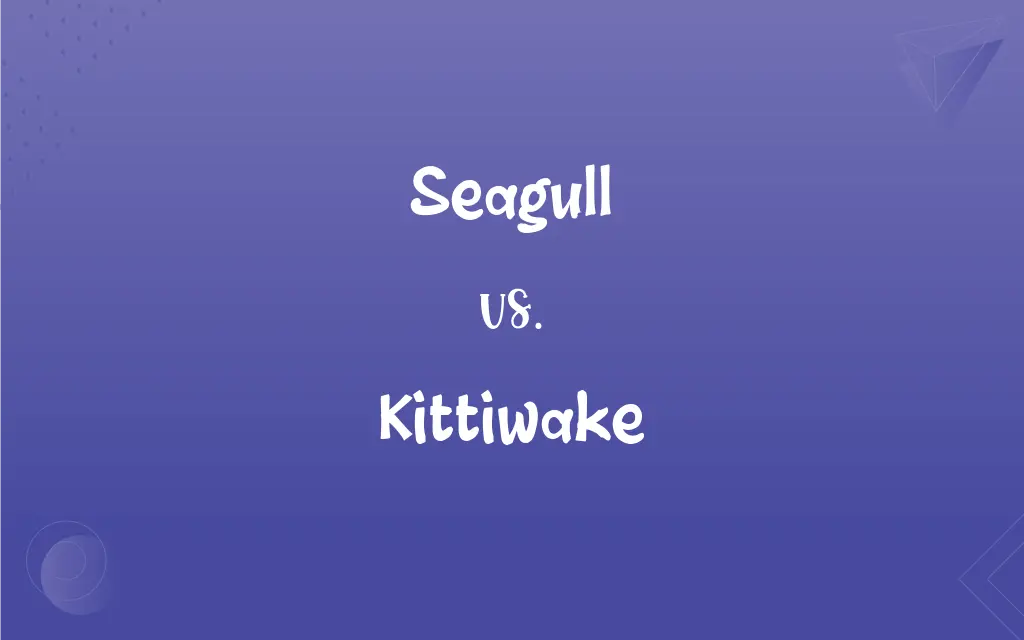Seagull vs. Kittiwake: What's the Difference?
Edited by Janet White || By Harlon Moss || Updated on November 3, 2023
Seagulls are a broad group of gregarious coastal birds; kittiwakes are smaller, cliff-nesting gulls with distinct 'kitti-wake' calls.

Key Differences
Seagulls are a ubiquitous sight at coastlines around the world, often spotted in large, noisy flocks. These birds are not a single species but belong to the family Laridae, which encompasses various gull species. In contrast, kittiwakes are more specific members of the gull family, known scientifically as Rissa tridactyla (common kittiwake) and Rissa brevirostris (Red-legged kittiwake).
Kittiwakes are easily distinguishable from the typical seagull by their nesting habits. While seagulls may nest in a variety of coastal environments and occasionally inland, kittiwakes prefer to nest on cliff faces, often in large, densely packed colonies. This preference for cliff nesting sites sets kittiwakes apart from their more versatile seagull relatives.
The call of a kittiwake is distinctive and is the source of its name, with a high-pitched 'kitti-wake' sound. Seagulls, on the other hand, have a range of vocalizations, which can include harsh caws and squawks. The vocal differences are often the easiest way to distinguish between the two when observed in their natural habitats.
In terms of appearance, kittiwakes are generally smaller than many seagulls, with a more delicate build and lighter flight. Seagulls tend to be larger and can vary greatly in size and color, depending on the species. For example, kittiwakes have short legs and a small yellow bill, while seagulls often have longer legs and larger bills, which can be yellow, red, or black-tipped.
Seagulls are known for their generalist feeding habits, often scavenging and opportunistic, while kittiwakes are more specialized, typically feeding on small fish which they catch at the surface of the ocean. The dietary habits of kittiwakes are a reflection of their life on the open sea, contrasting with the more adaptable diet of seagulls that can exploit a variety of ecological niches.
ADVERTISEMENT
Comparison Chart
Word Class
Noun (common noun)
Noun (common noun)
Plurality
Plural: seagulls
Plural: kittiwakes
Origin of Name
General term, not species-specific
Named for its call
Usage in Literature
Often used metaphorically
Rarely used metaphorically
Syllables
Two (sea-gull)
Three (kit-ti-wake)
ADVERTISEMENT
Seagull and Kittiwake Definitions
Seagull
Any of various gulls; and the term is often applied to the herring gull (Larus argentatus).
Seagulls gathered clamorously at the marina at dusk.
Kittiwake
The term refers to either of the two species in the genus Rissa.
The biologist noted that the kittiwakes had returned to their breeding grounds early this year.
Seagull
A large, white or gray coastal bird often found near the sea.
A seagull swooped down to snatch a fry from the boardwalk.
Kittiwake
A seabird known for its graceful flight and life at sea, rarely seen on land.
Kittiwakes soared above the cold, churning waters of the North Sea.
Seagull
A common name for sea-faring birds known for their loud, harsh cries.
The seagull's cry echoed over the waves.
Kittiwake
A small gull with a distinctive call, found primarily in northern regions.
A pair of kittiwakes nested on the cliff face.
Seagull
A bird associated with maritime environments, noted for scavenging behaviors.
Seagulls circled the fishing boat, waiting for scraps.
Kittiwake
A bird whose name imitates its call, often heard at large breeding colonies.
The air was filled with the 'kitti-wake' calls of the nesting birds.
Seagull
A symbol in literature and culture representing freedom or the nuisance of nature.
To her, the lone seagull represented an unattainable freedom.
Kittiwake
A cliff-nesting bird with a white body and gray wings.
The kittiwake's plumage blended with the foggy coastal skies.
Seagull
A gull, especially one found near coastal areas.
Kittiwake
Either of two gray gulls, Rissa tridactyla or R. brevirostris of northern oceans, that nest in colonies on sea cliffs.
Kittiwake
Either of two small gulls in the genus Rissa of the family Laridae that nest in colonies on sea cliffs and spend the winter on the open ocean.
Kittiwake
A northern gull (Rissa tridactyla), inhabiting the coasts of Europe and America. It is white, with black tips to the wings, and has only three toes.
Kittiwake
Small pearl-gray gull of northern regions; nests on cliffs and has a rudimentary hind toe
FAQs
Are kittiwakes a type of seagull?
Yes, kittiwakes are a type of seagull, belonging to the gull family.
Are all seagulls the same size?
No, seagulls vary greatly in size and appearance across different species.
Do seagulls and kittiwakes have the same diet?
No, seagulls have a more varied diet, while kittiwakes primarily eat small fish.
What distinguishes a kittiwake's nesting habits?
Kittiwakes exclusively nest on cliffs, whereas other seagulls may nest in a variety of coastal environments.
Are kittiwakes protected species?
Some kittiwake populations are protected due to their declining numbers from environmental threats.
Can seagulls drink salt water?
Yes, seagulls have special glands that allow them to excrete excess salt, enabling them to drink salt water.
What is a seagull?
A seagull is a common name for various species of coastal birds in the family Laridae.
Can seagulls be found inland?
Yes, some seagulls species are adaptable and can often be found inland, near bodies of water.
Do kittiwakes interact with humans?
Kittiwakes are less likely to interact with humans as they spend most of their life at sea and nest on cliffs.
Are seagull populations stable?
Some seagull populations are stable or increasing, while others face threats from pollution and habitat loss.
Why do kittiwakes have red legs?
The Red-legged kittiwake, a relative of the common kittiwake, has red legs which is a species-specific trait.
Are seagulls social birds?
Yes, seagulls are very social and often form large, noisy colonies.
What is the kittiwake's call like?
The kittiwake has a distinctive 'kitti-wake' call, which is where its name originates.
Are kittiwakes found worldwide?
Kittiwakes are mostly found in the colder northern regions of the Atlantic and Pacific Oceans.
Why are seagulls often seen as pests?
Seagulls can be considered pests due to their scavenging behavior and aggressive pursuit of food around humans.
What colors are seagulls?
Seagulls are generally white with varying shades of gray or black on their wings and back.
How do kittiwakes contribute to their ecosystem?
Kittiwakes play a role in their ecosystem as both predator and prey, and their guano enriches coastal environments.
Do kittiwakes migrate?
Yes, kittiwakes are migratory birds, traveling long distances between breeding and wintering grounds.
What is the lifespan of a seagull?
Seagulls can live up to 20 years or more, depending on the species.
How many eggs do kittiwakes lay?
Kittiwakes usually lay one to three eggs per breeding season.
About Author
Written by
Harlon MossHarlon is a seasoned quality moderator and accomplished content writer for Difference Wiki. An alumnus of the prestigious University of California, he earned his degree in Computer Science. Leveraging his academic background, Harlon brings a meticulous and informed perspective to his work, ensuring content accuracy and excellence.
Edited by
Janet WhiteJanet White has been an esteemed writer and blogger for Difference Wiki. Holding a Master's degree in Science and Medical Journalism from the prestigious Boston University, she has consistently demonstrated her expertise and passion for her field. When she's not immersed in her work, Janet relishes her time exercising, delving into a good book, and cherishing moments with friends and family.
































































